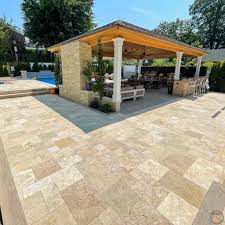When it comes to installing travertine pavers for patios, walkways, or pool decks, one common question homeowners and contractors ask is whether polymeric sand is the right choice for filling joints. While polymeric sand is widely used with concrete pavers, its compatibility with natural stone—especially travertine—needs a closer look.
What Is Polymeric Sand?
Polymeric sand is a blend of fine sand and special additives that harden when exposed to water. Once it cures, it locks pavers in place, minimizes weed growth, and prevents ants from nesting between joints. It’s designed to create a firm, long-lasting joint.
Challenges with Travertine Pavers
Unlike manufactured concrete pavers, travertine is a porous natural stone. This porosity can create issues:
-
Staining Risk: The polymers and colorants in the sand can seep into the stone’s surface, leaving permanent stains or a “haze.”
-
Uneven Joints: Travertine pavers often have slightly irregular edges, making it harder for polymeric sand to bond and cure evenly.
-
Moisture Trapping: Improper application can trap water under the stone, which may cause erosion, efflorescence, or even cracking over time.
Is It Safe to Use Polymeric Sand on Travertine?
It can be used—but only with extra precautions. Contractors often recommend sealing the travertine before applying polymeric sand to protect the stone’s pores from absorbing the polymer dust. Even then, it requires very careful sweeping and compacting to avoid residue sticking to the surface.
Many professionals prefer alternative joint fillers, such as:
-
Silica or natural jointing sand – Less risk of staining.
-
Stone dust or crushed stone – Blends naturally with the paver material.
-
Specialized non-polymeric joint compounds – Designed specifically for natural stone.
Best Practices if You Choose Polymeric Sand
If you decide to go with polymeric sand, follow these steps for the best results:
-
Seal the Travertine First – Apply a quality penetrating sealer to reduce absorption.
-
Work in Small Sections – Sweep and compact the sand carefully before misting with water.
-
Clean Excess Immediately – Use a leaf blower or broom to remove all dust before activating with water.
-
Follow Manufacturer’s Instructions – Each brand may have slightly different curing times and water requirements.
Final Thoughts – Can you use polymeric sand on travertine pavers?
Polymeric sand can technically be used with travertine pavers, but it comes with risks that may outweigh the benefits. If you value the natural look of your travertine and want to avoid potential staining, traditional joint sand or stone dust may be the safer choice. For the best outcome, consult with a stone professional who has experience specifically with natural stone paver installations.

